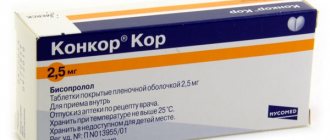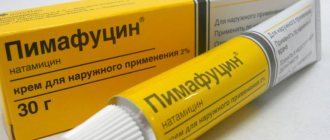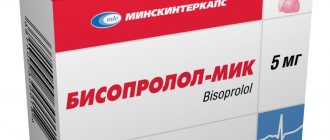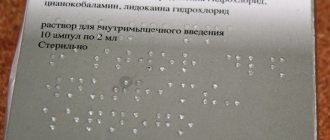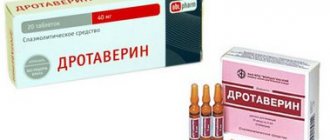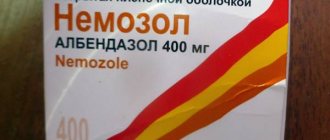Sometimes the baby's blood contains minimal amounts of potassium, causing a hypokalemic state. Hypokalemia is prevented and treated with Asparkam, therefore Asparkam is prescribed to children. Let us consider in detail the description of hypokalemia. In this condition, not only will there be a deficiency of potassium in the blood, but also in cellular structures. This poses a danger to the myocardium of the heart. Children will experience cardiac dysfunction and convulsive syndrome.
If a child’s body experiences a potassium deficiency, then the child always wants to sleep. Breasts refuse to breastfeed, they have dry skin, and flatulence occurs. The baby often spits up and sometimes vomits. Blood pressure (BP) will decrease, heart rhythm will be disrupted, and tachycardia will appear. If hypokalemia progresses, flaccid paralysis of the smooth myofibers of the intestinal tract will occur, and constipation with colic will appear. If left untreated, the child will die.
A lack of potassium in the blood occurs due to the fact that the child often vomits or has diarrhea, which is characteristic of intoxication syndrome. Another hypokalemic state will manifest itself due to:
- Dysfunctions of the gastrointestinal tract (GIT).
- Kidney, liver pathologies, adrenal dysfunction.
- Treatment with hormones and diuretics.
For example, treatment with Diacarb (a diuretic) is used to reduce intracranial pressure and also prevent cerebral edema. Therapy takes a long time, Diacarb removes potassium, so there is less potassium in the blood, so Asparkam is used for children to normalize potassium levels. You can read about the possibility of prescribing Asparkam during pregnancy in this article.
Pharmacological effect
The therapeutic effect of the drug is based on the fact that aspartates move potassium ions into the intracellular area, and they also participate in metabolic processes. Electrolyte balance will be restored, potassium and magnesium deficiency will be replenished, and the excitability and conductivity of the myocardial membrane of the heart will decrease. The product normalizes heart rate, myocardial metabolic processes, and improves microcirculation.
The absorption of the drug is rapid, it is eliminated due to renal function. An hour or two hours after taking the drug, potassium and magnesium levels in the blood will be maximum. From the bloodstream, the components of the drug will reach the cardiomyocytes in the form of magnesium and potassium ions, which will be introduced into cellular metabolic processes.
conclusions
In therapy, cardiology and transfusiology, solutions of potassium and magnesium aspartate are used to compensate for the deficiency of K+ and Mg2+ cations. The drug "Asparkam" is indicated for the correction of electrolyte imbalance in laboratory-confirmed hypokalemia and hypomagnesemia. Rational use of the drug in accordance with clinical need and the individual needs of the patient minimizes the risk of adverse reactions and overdose with a life-threatening condition.
The following sources of information were used to prepare the material.
Compound
The drug contains potassium and magnesium salts. The basis of the medicine is potassium. It eliminates arrhythmia and restores cardiac function. Magnesium transports potassium to cellular structures. Magnesium also supplies energy that cells need. Using Asparkam for children will restore the balance of electrolytes. Hypoxia will decrease and the function of internal organs responsible for digestion will improve.
The drug is prescribed to eliminate the hypokalemic state after treatment with glucocorticoids.
In what form is it produced?
The medication is available in 2 dosage forms - tablets and injections. The tablets are white, fairly large in size and flat-round in shape. In addition, patients note the specific smell of the medicine.
The tablets are packaged in blisters of 50 pieces. Each blister is in an individual cardboard box, where you can also find instructions for use. The price of tablets starts from 70 rubles. per package.
In addition, the drug is available in the form of a solution for intravenous infusion. It is transparent, colorless, sometimes has a yellowish tint. The solution is packaged in ampoules of 5 or 10 ml. The cardboard box contains instructions and 10 ampoules of medication. The cost of such a box is approximately 100-150 rubles. depending on the region of distribution.
Application
The instructions for use do not prohibit treating an infant with Asparkam. Pills, droppers or injections are prescribed. What is the product used for? For infants, the drug is prescribed in the following cases:
- With low potassium levels, which is dangerous for the heart.
- If there is heart failure.
- When a child suffers from cardiac ischemia.
- State of shock.
- In case of abnormal heart rhythm or other heart pathologies.
Asparkam is safe because it contains magnesium and potassium
To prevent the drug from accumulating in the body, it is used with agents that will remove it. For this purpose they are treated with Diacarb. In severe hypokalemic conditions, the following is indicated:
- Intravenous administration of Asparkam.
- It is administered very slowly, using a drip or jet method of administration.
- Before administering the product, it is diluted with a 5% glucose solution.
- Rapid administration of the medication is contraindicated. An overdose will occur, the symptoms of the pathology will intensify, loss of consciousness and increased drowsiness are possible.
Before using the drug on an infant, the baby’s body weight, the volume of excess cerebrospinal fluid, general condition with developmental characteristics, and other circumstances are taken into account. The tablet is ground to a powder form, water is added, and the child is given the product to drink. After he has taken the medicine, it is recommended to breastfeed the baby, since Asparkam has an unpleasant taste.
In case of hypokalemic condition, arrhythmia, the drug is taken for 1 or 2 weeks, where the dosage depends on the age of the child:
- Up to a year, take a fourth of the tablet once a day.
- From 1 year to 3 years of age - half a tablet 1 time per day.
- From 3 to 6 years - half a tablet 2 times a day.
- From 7 to 10 years - half a tablet 3 times a day.
- From 11 to 12 years - 1 tablet 1 or twice a day.
- From 13 to 16 years old, take 1 tablet 2 times a day.
- From the age of 16, the tablet is taken three times a day.
Such dosages are approximate; they should only be determined by a doctor who is familiar with the individual characteristics of the child’s body. Diacarb with Asparkam is used for infants according to the following plan. Give the child a quarter of an Asparkam tablet and the same amount of Diacarb per day every 3 days for 30 days. They take a quarter of Asparkam and the same amount of Diacarb per day, then take a break for two days.
How to use Asparkam for tachycardia?
This drug is a combination drug that experts prescribe for the treatment of various heart and vascular diseases. What properties does the above drug have? How to properly use this medicine for palpitations? The answers to these questions can be found in this article.
The above drug should only be prescribed by the attending physician after a complete examination of the patient, an accurate diagnosis and the exclusion of contraindications for use. It should be understood that the use of Asparkam alone cannot significantly improve the patient’s condition with tachycardia, since such a drug is used to enhance the effectiveness or prevent unwanted side effects from other drugs.
The drug is available in tablets and injection solutions. In most cases, when treating tachycardia, it is prescribed in tablets, which are taken 1-2 pieces three times a day, preferably after meals (the injectable form is mainly used to treat other diseases). The duration of the course is determined by the attending physician based on the patient’s condition, on average from 10 to 14 days.
Asparkam has a very low price compared to other drugs. You can purchase this drug at your nearest pharmacy without a special prescription. Store in a dry place, away from direct sunlight and hot temperatures. Shelf life is up to 3 years.
Treatment of rapid heartbeat with Asparkam should be carried out exclusively under the supervision of a doctor, in combination with other pharmacological agents, since Asparkam only enhances the effect of other drugs. And independent treatment may not only not bring the desired result, but also significantly worsen the patient’s condition.
Overdose
In case of overdose, a hyperkalemic with hypermagnesemic state will occur. The patient's face will turn red, he will be very thirsty, his blood pressure will drop, the conduction of impulses in the nerves and muscles will be disrupted, the heart rhythm will be disrupted, convulsions will occur, and the respiratory center will be depressed.
If dangerous symptoms occur after an overdose of Asparkam, the patient requires urgent medical attention
Interaction with other means
Asparkam, interacting with other medications, can cause different effects. Constipation and a high concentration of potassium in the bloodstream may occur when using angiotensin-converting enzyme inhibitors, potassium-sparing diuretics, Heparin with β-blockers, Cyclosporine with non-steroidal drugs that relieve inflammation.
When treated with Asparkam, cardiac glycosides will be better tolerated, they will have a less toxic effect on the body, since their side effects will be completely eliminated. Potassium with magnesium aspartate will increase the effect of anesthetics and antidepolarizing muscle relaxants, but the effect of antibiotics will decrease. When treated with Asparkam, the absorption of drugs containing iron with Tetracycline, Streptomycin, and sodium fluoride is inhibited.
The simultaneous use of Asparkam with glucocorticoids and diuretics that do not conserve potassium will restore potassium deficiency and reduce the likelihood of developing a hypokalemic state.
Pharmacodynamics
Asparkam is a drug that regulates the metabolism of potassium and magnesium in the body. Tablets and solution help eliminate severe symptoms of many pathologies of the heart and blood vessels. Their price allows any patient to undergo a course of therapy.
The drug is considered antiarrhythmic and also helps restore electrolyte balance due to rapid penetration into cells. Potassium and magnesium in the composition of the drug circulates in the systemic bloodstream, reduces the conductivity of the heart, which facilitates its work and reduces sensitivity to many potent medications.
Contraindications and side effects
The use of the drug is prohibited in case of severe renal pathologies, various heart blocks, and also in cases where the components of the tablets are not tolerated by the child. The medicine is not used in cases of increased concentrations of magnesium and potassium in the blood, low urine output, 2nd and 3rd degree atrioventricular blockades, erythrocyte hemolysis, adrenal dysfunction, shock, acute blood acidosis, dehydration, methanol poisoning, and impaired amino acid metabolism.
With rapid intravenous administration of Asparkam, hypermagnesemia with hyperkalemia will occur
Mother and father must know that if the dose of medication is exceeded, the child will feel nauseous, vomit, his stomach will swell, blood pressure will decrease, the heart will slow down, diarrhea will appear, and muscles will weaken. Also, the baby will feel discomfort in the epigastric zone, ulcers will appear on the gastric and intestinal mucosa, hemorrhages, and allergic reactions will occur. It is important to remember that a doctor must draw up a treatment regimen; it is prohibited to take the medicine yourself. Self-medication will cause complications that pose a threat to life; they are not always treated successfully.
Asparkam dosage regimen
In order for Asparkam to be beneficial and not harmful, you should consult a doctor before using it.
In some cases, the medicine is injected into a vein. Before administering Asparkam, 1-2 ampoules are diluted in 50 or 100 ml of 5% glucose solution.
Scheme for the prevention of cardiovascular pathologies
Asparkam should be taken 1-2 tablets three times a day for 21-28 days. If necessary, the preventive course can be repeated.
Dosages in sports
During “drying” you need to take the medicine for a month. Longer use is permissible only after consultation with a sports doctor. You should also consult a specialist about the advisability of parenteral administration of Asparkam.
Use in pediatrics
The medicine is not used in pediatric practice, since it is unknown whether it will harm or benefit children.
Use during pregnancy
Whether Asparkam can be prescribed to pregnant women should be clarified in the official instructions. For example, HMZ “Red Star” tablets can be taken with caution during pregnancy, especially in the first trimester, if the benefit to the mother is greater than the possible harm to the fetus. But the injection solution, which is produced by the Biosynthesis company, is prohibited for such women.
